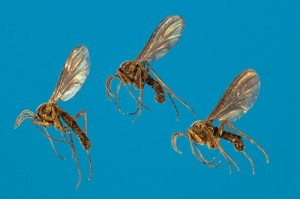 The little fungus gnat is an increasingly common nuisance fly. There are two primary families of gnat found in North America, the Sciaridae and Mycetophilidae. Within these two families, there have been nearly 137 species of Sciaridae and about 714 species of Mycetophilidae identified. The primary difference between the two families is in the size of the flies and the color and patterns in their wings. The Sciaridae are commonly called dark-winged fungus gnats because of the smoky coloration of their wings.
The little fungus gnat is an increasingly common nuisance fly. There are two primary families of gnat found in North America, the Sciaridae and Mycetophilidae. Within these two families, there have been nearly 137 species of Sciaridae and about 714 species of Mycetophilidae identified. The primary difference between the two families is in the size of the flies and the color and patterns in their wings. The Sciaridae are commonly called dark-winged fungus gnats because of the smoky coloration of their wings.
These are tiny flies, ranging from 1/32 in. to 1/2 in. long. There is relatively little actually known about the biology of these flies, aside from the basics. Like all flies, they go through a complete metamorphosis. The Sciaridae larvae go through four molts before moving into the pupae stage, while the Mycetophilidae larvae pass through five molts. There’s one Sciaridae species that reproduces through parthenogenesis (without the egg being fertilized). There is also one species from the Mycetophilidae family that has larvae that glow, or fluoresce.
The lifespan of these flies, from egg to egg, is about 10 days for most species. Within this period, the females can create as many as 200 eggs. The eggs will be placed in areas where the larvae have an adequate food supply. For most species, this food is — as the common name implies — a fungal growth of some type. The Sciaridae family prefer fungal growth associated with decaying plant materials and animal excrement. The Mycetophilidae family prefer fungus associated with wood, tree bark and small animal nest sites. A few of the larvae in this family have been observed spinning fine web material and capturing tiny arthropods for food.

Fungus gnats. Photo courtesy of, and copyrighted by, Gene White, pmimages@earthlink.net
The pest status of these flies is classified as nuisance, but a few species can create economic problems. Because of their fondness for fungus, places such as mushroom farms, greenhouses and potato farms are at risk of damage. In new construction, they often become a problem when the tightly sealed walls develop fungus growth inside. At commercial properties, they often become problematic in interior plantscape features inside the buildings.
Adult fungus gnats are relatively weak flyers. They tend to flutter more than fly. Because of this, adults don’t move far from the breeding area unless there is sufficient air flow to carry them along. When airborne, most species are attracted to lights and can be found in insect light
traps (ILTs).
Moisture is the key element that these flies need. Without the presence of moisture, the fungus won’t grow well, if at all. Adult fungus gnats also require water to sustain them. The adults do not eat the fungus, but will drink water during their short lives.
While we don’t know much about the biology and life of these tiny insects, what we know should provide us with all the clues necessary to control them for our clients. Just think like the fly!
Contact Meek, international technical and training director for Orkin, at fmeek@rollins.com.
Leave A Comment